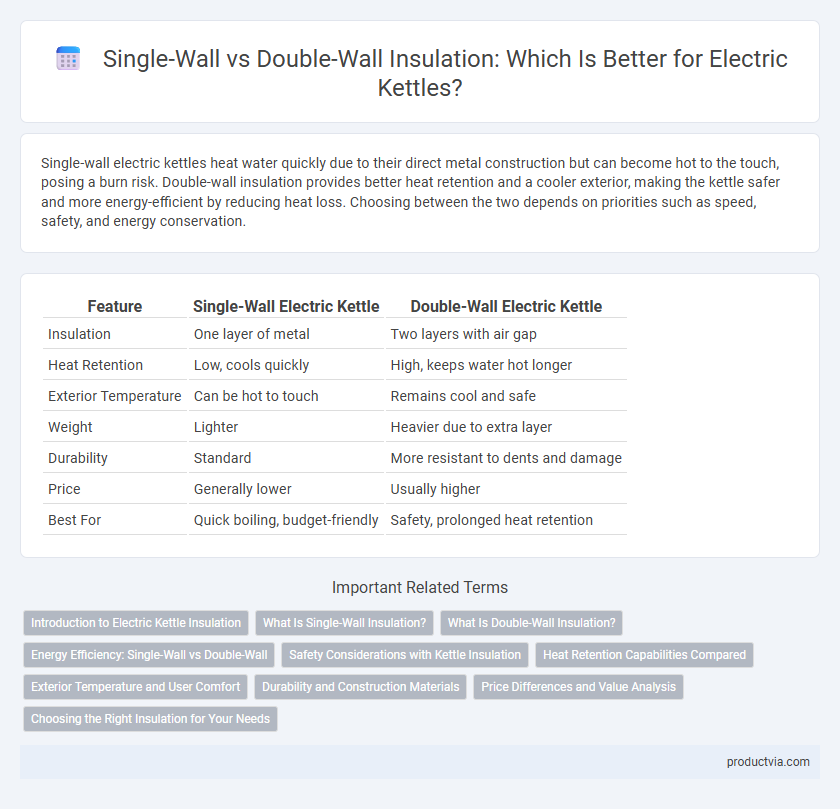Single-wall electric kettles heat water quickly due to their direct metal construction but can become hot to the touch, posing a burn risk. Double-wall insulation provides better heat retention and a cooler exterior, making the kettle safer and more energy-efficient by reducing heat loss. Choosing between the two depends on priorities such as speed, safety, and energy conservation.
Table of Comparison
| Feature | Single-Wall Electric Kettle | Double-Wall Electric Kettle |
|---|---|---|
| Insulation | One layer of metal | Two layers with air gap |
| Heat Retention | Low, cools quickly | High, keeps water hot longer |
| Exterior Temperature | Can be hot to touch | Remains cool and safe |
| Weight | Lighter | Heavier due to extra layer |
| Durability | Standard | More resistant to dents and damage |
| Price | Generally lower | Usually higher |
| Best For | Quick boiling, budget-friendly | Safety, prolonged heat retention |
Introduction to Electric Kettle Insulation
Single-wall electric kettles feature a single layer of metal that heats quickly but transfers heat to the exterior, making the kettle hot to touch. Double-wall insulation incorporates an inner heating chamber surrounded by an insulating layer and an outer shell, enhancing heat retention and reducing surface temperature. Choosing between single-wall and double-wall insulation impacts energy efficiency, safety, and user comfort in electric kettle design.
What Is Single-Wall Insulation?
Single-wall insulation in electric kettles consists of a single layer of metal or plastic that directly encloses the heating chamber, allowing faster heat transfer for quicker boiling times. This design typically results in a lighter and more affordable kettle but offers minimal heat retention and may cause the exterior surface to become hot to the touch. Single-wall kettles are suitable for users prioritizing speed and compactness over thermal insulation and safety.
What Is Double-Wall Insulation?
Double-wall insulation in an electric kettle consists of two layers of stainless steel separated by an insulating air gap that significantly reduces heat transfer. This design maintains the water temperature longer while keeping the outer surface cool to the touch, enhancing both energy efficiency and user safety. Compared to single-wall kettles, double-wall models provide superior heat retention and prevent accidental burns.
Energy Efficiency: Single-Wall vs Double-Wall
Single-wall electric kettles heat water faster due to direct contact between the heating element and water, but they lose heat quickly, reducing overall energy efficiency. Double-wall kettles provide superior insulation by trapping air between layers, significantly minimizing heat loss and maintaining water temperature longer, which enhances energy conservation. Choosing double-wall insulation can result in lower electricity consumption and more sustainable use over time.
Safety Considerations with Kettle Insulation
Single-wall electric kettles have a thinner construction, which increases the risk of external surface burns due to heat transfer, posing safety concerns especially in households with children. Double-wall insulation provides an extra protective layer that significantly reduces surface temperature, minimizing burn hazards and enhancing safe handling. This design also prevents accidental spills by maintaining a cooler exterior, making double-wall kettles a safer choice for everyday use.
Heat Retention Capabilities Compared
Single-wall electric kettles have minimal insulation, leading to faster heat loss and reduced heat retention capabilities, which can cause water to cool quickly after boiling. Double-wall insulated electric kettles incorporate an air gap or vacuum between two layers of stainless steel or glass, significantly enhancing heat retention by preventing heat from escaping. This design maintains the water temperature longer, improves energy efficiency, and offers safer handling by keeping the exterior cooler to the touch.
Exterior Temperature and User Comfort
Single-wall electric kettles often have higher exterior temperatures, which can pose a burn risk and reduce user comfort during handling. Double-wall insulation significantly lowers the outer surface heat, maintaining a cooler exterior that enhances safety and ease of use. This thermal barrier not only protects users from accidental burns but also improves overall comfort when pouring or carrying the kettle.
Durability and Construction Materials
Single-wall electric kettles feature a single layer of metal, typically stainless steel, offering straightforward durability but limited heat retention. Double-wall insulation uses two layers of stainless steel with an air gap in between, enhancing heat retention and providing a cooler exterior surface for safer handling. Construction materials like high-grade stainless steel and BPA-free plastic in double-wall kettles contribute to longevity and improved thermal performance compared to single-wall models.
Price Differences and Value Analysis
Single-wall electric kettles generally cost less due to simpler construction, making them budget-friendly options for basic boiling needs. Double-wall kettles, featuring an insulating air gap or foam layer, command higher prices but offer superior heat retention and external cool-touch surfaces, enhancing safety and energy efficiency. Evaluating value involves balancing upfront cost against long-term savings from reduced energy consumption and improved user comfort.
Choosing the Right Insulation for Your Needs
Single-wall insulation in electric kettles offers quicker boiling times and lighter weight, making it ideal for those prioritizing speed and portability. Double-wall insulation provides superior heat retention and external coolness, enhancing safety and energy efficiency for frequent use or households with children. Selecting the right insulation depends on balancing the need for rapid heating against safety and heat preservation preferences.
Single-wall vs double-wall insulation for electric kettle Infographic

 productvia.com
productvia.com